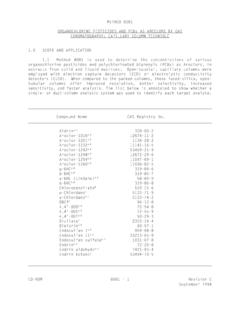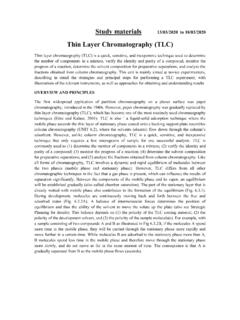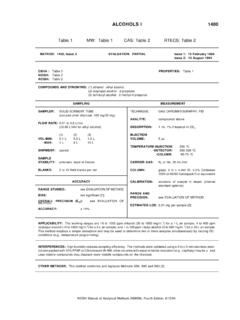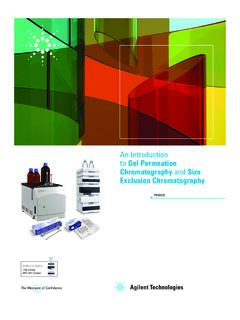Transcription of METHANOL 2000
1 NIOSH Manual of Analytical Methods (NMAM), Fourth EditionMETHANOL2000CH3OH MW: CAS: 67-56-1 RTECS: PC1400000 METHOD: 2000 , Issue 3 EVALUATION: FULL Issue 1: 15 August 1984 Issue 3: 15 January 1998 OSHA : 200 ppmNIOSH: 200 ppm (skin); STEL 250 ppm (skin) ACGIH: 200 ppm (skin); STEL 250 ppm (skin)(1 ppm = mg/m3 @ NTP)PROPERTIES:liquid; d = g/ml @ 20 C; BP = C;VP = kPa (115 mm Hg; v/v) @ 20C; explosive range is 6 to 36% (v/v) in airSYNONYMS: Methyl alcohol, wood alcohol, carbinol, wood naphtha, wood spirit SAMPLINGMEASUREMENTSAMPLER:SOLID SORBENT TUBE(silica gel, 100/50 mg)FLOW to L/minVOL-MIN:1 L @ 200 ppm -MAX:5 LSHIPMENT:pack securely for shipment; store at STABILITY :at least 30 days at 5C [1]BLANKS:2 to 10 field blanks per setTECHNIQUE:GAS chromatography , FIDANALYTE:methanolDESORPTION:1 mL water/isopropanol (95:5) [1]INJECTION VOLUME:1 L TEMPERATURE- INJECTION:250 C-DETECTOR:300 C -COLUMN:50 to 90 C (8 C/min) [1](Split Ratio 10:1)CARRIER GAS:He, mL/minCOLUMN: capillary , 30 m x ID; 3- m film35% diphenyl-65% dimethyl polysilozane,Rtx -35 or equivalent [1]CALIBRATION:standard solutions of METHANOL inwater/isopropanol (95:5) to 6000 g per sample [1,2]ESTIMATED g per sample [1]PRECISION (r) [1]ACCURACYRANGE STUDIED:140 to 540 mg/m3 [2] OVERALL PRECISION (rT) [1, 2]ACCURACY: APPLICABILITY: Under the GC parameters stated in the method, METHANOL may be identified based upon retention time and working range is to 1200 mg/m3 ( to ppm) for a 5-L air sample [1].
2 At high concentrations of METHANOL or under conditionsof high relative humidity, a large silica gel tube (700 mg) is required [2].INTERFERENCES: No specific interferences were identified. However, any compound with a similiar retention time may identification can be confirmed by dual column chromatography with a 100% PEG capillary column. Mass spectrometry can alsobe used as a confirmation METHODS: This method updates and replaces NMAM 2000 (August 15, 1994), which combined and replaced Method S59[3] and P&CAM 247 [4]. METHANOL : METHOD 2000 , Issue 3, dated 15 January 1998 - Page 2 of 4 NIOSH Manual of Analytical Methods (NMAM), Fourth , chromatographic grade. * , distilled and (IPA), chromatographic grade.* , , , solution, 5% isopropanol in 95%distilled stock solution, 2 g/ L. Add LMethanol to 10 mL of desorbing solution.* See SPECIAL : silica gel tube, 7 cm long, 4-mm ID,containing two sections of 20/40 mesh silica gel(front = 100 mg, back = 50 mg) separated by a2-mm urethane foam plug.
3 A silylated glasswool plug precedes the front section. A 4-mmfoam plug follows the back section. Samplersare commercially :At high relative humidity or highmethanol concentrations, use a largertube: 15 cm long, 8-mm ID, with threesections of silica gel (700 mg, 150mg, 150 mg). sampling pump, to L/min,with flexible connecting chromatograph, flame ionization detection,integrator, and Rtx-35 capillary column, orequivalent (page 2000 -1). , autosampler, with PTFE-lined syringes, 10- L and other sizes as needed, readable to , volumetric, various , various sizes. SPECIAL PRECAUTIONS: METHANOL is flammable and a dangerous fire and explosion risk. It ismoderately toxic by ingestion and inhalation. Isopropanol is flammable and a fire risk. Wear appropriateprotective clothing and work with these compounds in a well ventilated each personal sampling pump with a representative sampler in ends of sampler immediately before sampling.
4 Attach sampler to personal sampling pumpwith flexible at an accurately known flow rate between and L/min for a total sample size of 1to 5 the samplers with plastic caps and pack securely for shipment. SAMPLE front (include glass wool plug) and back sorbent sections of the sampler tube in separatevials. Discard foam plugs. 1 mL of water/IPA (95/5) to each vial and attach crimp vials in an ultrasonic bath for 30 to 60 min to aid AND QUALITY daily with at least six working standards over the range of interest. Three standards (induplicate) should cover the range from LOD to known amounts of calibration stock solution to water/isopropanol (95/5) in 10-mLvolumetric flasks and dilute to the together with samples and blanks (steps 11 and 12). calibration graph (peak area or height vs. g METHANOL ). desorption efficiency (DE) at least once for each lot of silica gel tubes used for samplingMETHANOL: METHOD 2000 , Issue 3, dated 15 January 1998 - Page 3 of 4 NIOSH Manual of Analytical Methods (NMAM), Fourth EditionC(WfWbBfBb)V,mg/m3in the calibration range (step 8).
5 Prepare three samplers at each of six levels plus three and discard back sorbent sections of samplers and media a known amount of calibration stock solution directly onto the front sorbent bed of eachsilica gel tube. the tubes to air equilibrate for several minutes, then cap the ends of the tubes and allowto stand the samples (steps 5 through 7) and analyze together with working standards andblanks (steps 11 and 12). a graph of DE vs. g analyte recovered. three quality control blind spikes and three analyst spikes to ensure that the calibrationgraph and DE graphs are in gas chromatograph according to manufacturer s recommendations and to conditions given onpage 2000 -1. Inject a 1- L sample aliquot manually using solvent flush technique or with anautosampler. NOTE:If peak area is above the linear range of the working standards, dilute with water/IPA(95/5), reanalyze and apply the appropriate dilution factor in the peak the mass, g (corrected for DE), for METHANOL found in the sample front (Wf) and back(Wb) sorbent sections, and in the average media blank front (Bf) and back (Bb)sorbent : If Wb > Wf/10, report breakthrough and possible sample concentration, C, of METHANOL in the air volume sampled, V (L) NOTE: g/L mg/m3 EVALUATION OF METHOD:The method was reevaluated and revised.
6 Improvements were made to enhance the recovery of methanolfrom silica gel, to improve baseline resolution, and to improve the precision of the method. Desorptionefficiency (DE) was determined for three levels using the improved analytical parameters stated on page2000-1. The average DE for METHANOL was determined at 20 g ( ), 40 g ( ), and 79 g ( )[1]. The LOD was determined to be g/sample [1]. The precision, as determined from the pooled relativestandard deviation (r) was determined to be [1]. The original method S59 [3] was issued on January 17, 1975 and was validated over the range of 140 to 540mg/m3 at 25 C and 758 mm Hg with 5-L sample volumes [2]. The estimated LOD determined for a usercheck was mg/sample [5]. Overall precision ( rT) was determined to be with an averagerecovery for 18 samples of , representing non-significant bias. The atmospheres were generated bycalibrated syringe pump. Desorption efficiency (DE) was determined to be at mg METHANOL and mg METHANOL per sample.
7 The breakthrough volume was L (5% on back section) when samplinga METHANOL atmosphere containing 541 mg/m3 in dry air at L/min for 52 gathered using larger silica gel tubes (700 mg front section) under conditions of high humidity werepublished in P&CAM 247 [4]. The data are consistent with a recommended maximum sample volume of 5 : METHANOL : METHOD 2000 , Issue 3, dated 15 January 1998 - Page 4 of 4 NIOSH Manual of Analytical Methods (NMAM), Fourth Edition[1] Pendergrass, SM [1996]. Backup data report for METHANOL method development. Cincinnati, OH:National Institute for Occupational Safety and Health, DPSE/NIOSH (unpublished May).[2]NIOSH [1977]. Documentation of the NIOSH validation tests. Cincinnati, OH: National Institute forOccupational Safety and Health, DHEW (NIOSH) Publication No. 77-185.[3]NIOSH [1977]. NIOSH Manual of Analytical Methods (NMAM), V. 2, S59. Cincinnati, OH: NationalInstitute for Occupational Safety and Health, DHEW (NIOSH) Publication No.
8 77-157-B.[4]NIOSH [1977]. NIOSH Manual of Analytical Methods (NMAM), V. 1, P&CAM 247. Cincinnati, OH:National Institute for Occupational Safety and Health, DHEW (NIOSH) Publication No. 77-157-A (1977).[5]NIOSH [1983]. User Check, UBTL, NIOSH Sequence # 4121-K (unpublished November 3).METHOD WRITTEN BY:Stephanie M. Pendergrass, NIOSH/DPSE

















